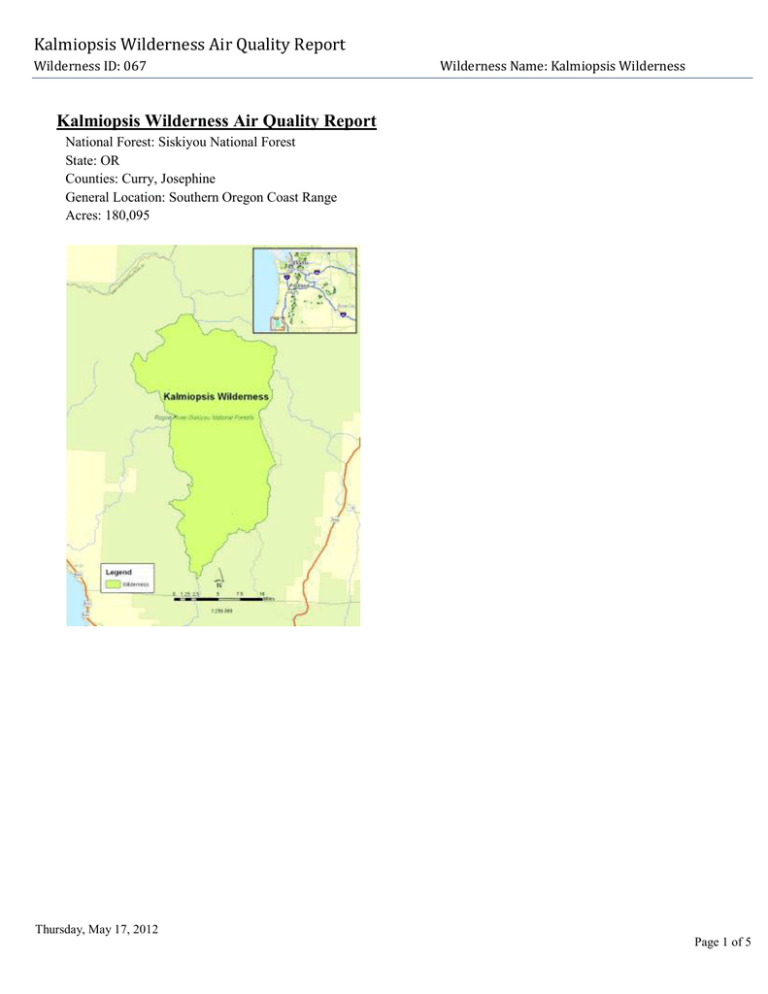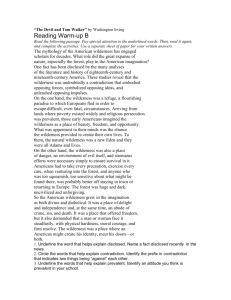Kalmiopsis Wilderness Air Quality Report
advertisement

Kalmiopsis Wilderness Air Quality Report Wilderness ID: 067 Wilderness Name: Kalmiopsis Wilderness Kalmiopsis Wilderness Air Quality Report National Forest: Siskiyou National Forest State: OR Counties: Curry, Josephine General Location: Southern Oregon Coast Range Acres: 180,095 Thursday, May 17, 2012 Page 1 of 5 Kalmiopsis Wilderness Air Quality Report Wilderness ID: 067 Wilderness Name: Kalmiopsis Wilderness Wilderness Categories Information Specific to this Wilderness Year Established 1964 Establishment Notes Endangered American Wilderness Act of 1978, The Wilderness Act of September 3,1964 Designation Clean Air Act Class 1 Administrative Rogue River-Siskiyou National Forest Unique Landscape Features This nearly 180,000 acre Wilderness includes the headwater basin of the Chetco and North Fork Smith Rivers and a portion of the Illinois River canyon. This is a harsh, rugged area with a unique character. Elevations range from 500 to 5,098 feet (Pearsoll Peak). The area is characterized by deep, rough canyons, sharp rock ridges and clear rushing mountain streams and rivers. Diversity of topography and geology provide excellent habitat for a wide variety of botanical species. The Kalmiopsis Wilderness is well known for its diversity of plant life. Much of this diversity results from plant species adapting to life in harsh soils derived from peridotite and serpentinite rocks. Both are rich in heavy metals such as magnesium, iron, chromium and nickel, which in high amounts, can be toxic to most plants. The diversity of plant habitat has been the result of a combination of geologic forces (uplift, folding and faulting), erosional and depositional forces (glaciation, weather, climate and the action of rivers), and periodic fires. The Kalmiopsis leachiana plant was discovered in 1930 by Lilla Leech in the Gold Basin area. The plant is a relic of the pre-ice age and the oldest member of the Health (Ericaceae) Family. The Kalmiopsis Wilderness was named after this unique endemic shrub. Besides being a place of great botanical interest, the Kalmiopsis Wilderness is also one of the most unusual and complex geological areas of our country. The Kalmiopsis is part of the Klamath Mountain geologic province of northwestern California and southwestern Oregon. The eastern half is part of the Josephine "ultramafic" sheet. Ultramafic denotes being very high in iron and magnesium. The western half is underlain by the contorted sedimentary rocks of the Dothan formation and by the igneous intrusive rocks of the Big Craggies. Most of the rocks in this province were formerly parts of the oceanic crust and included serpentine, submarine volcanic flow rocks, intrusive granite-like rocks, and sedimentary rocks such as shale and sandstone. The Wild segments of the Illinois, Chetco and North Fork Smith Rivers flow through the Kalmiopsis Wilderness, providing clear water, fish habitat and water-based recreation in a remote and primitive setting. Lake environments are limited, primarily to Babyfoot Lake on the eastern boundary and Vulcan Lake on the west. Since these areas are readily accessible from nearby trailheads, they do receive a greater amount of day-use visitation. The nearly 500,000 acre Biscuit Fire of 2002 included the entire wilderness area. The environment has changed dramatically and provides a unique opportunity to observe a natural response to fire disturbance through plant succession, erosional and depositional occurrences and changed habitat for flora and fauna. While the lightning caused fire was a natural event for the wilderness it did provide damage to the nearly 160 miles of trails and trailhead facilities. Large areas of high fire severity occurred, killing much of the overstory trees in these areas, which will result in continued damaged to the trail system over time. The trails have always been challenging due to their steepness and narrow rocky surface. The impact from the fire includes added challenges, such as large numbers of downed trees, missing trail signs, holes and lose rock on the tread etc. For now and in the foreseeable future, wilderness users should recognize the need for increased safety awareness when traveling and camping. Lakebed Geology Sensitivity N/A Lakebed Geology Composition Not Reported Thursday, May 17, 2012 Page 2 of 5 Kalmiopsis Wilderness Air Quality Report Wilderness ID: 067 Wilderness Categories Visitor Use Mean Annual Precipitation Elevation Range Mean Max Aug Temp Mean Min Dec Temp Lake Acres Pond Acres Lake Count Pond Count TES Flora TES Wildlife TES Fish Ozone Sensitive Plants Air Quality Sensitive Lichens Cultural Resources Status/Trends: Acid Deposition: Status/Trends: Nutrient Enrichment: Status/Trends: Ozone Impacts: Wilderness Name: Kalmiopsis Wilderness Information Specific to this Wilderness Not Reported Not Reported 65 - 1546 (meters) Not Reported Not Reported 10 8 4 9 Arabis aculeolata, Arabis koehleri var. stipitata, Arabis macdonaldiana, Arctostaphylos hispidula, Cardamine nuttallii var. gemmata, Carex scabriuscula, Cypripedium californicum, Cypripedium fasciculatum, Darlingtonia californica, Dicentra formosa ssp. oregona, Draba howellii, Epilobium rigidum, Ericameria arborescens, Erigeron cervinus, Eriogonum lobbii, Fritillaria glauca, Gentiana setigera, Hieracium bolanderi, Kalmiopsis leachiana, Leucothoe davisiae, Lewisia cotyledon var. cotyledon, Lilium pardalinum ssp. vollmeri, Lomatium martindalei, Lupinus tracyi, Minuartia howellii, Monardella purpurea, Packera hesperia, Rhizopogon truncatus, Salix delnortensis, Silene grayi, Smilax californica, Sophora leachiana, Streptanthus howellii, Thermopsis robusta Bald Eagle Not Reported Not Reported Not Reported Not Reported Not Reported Not Reported Not Reported AQRV's Fauna Fauna Priority: Medium Fauna Receptor: Fish Fauna Indicator: Concentration of methyl mercury Fauna Trends: Not Reported Fauna Actions: Sample fish in high visitor use lakes for mercury. Flora Flora Priority: High Flora Receptor: Lichens Flora Indicator: Changes in community composition Flora Trends: Not Reported Thursday, May 17, 2012 Page 3 of 5 Kalmiopsis Wilderness Air Quality Report Wilderness ID: 067 Wilderness Name: Kalmiopsis Wilderness Flora Priority 2: High Flora Receptor 2: Lichens Flora Indicator 2: Concentrations of N, S, P, Cd, Cr, Pb, Hg, Ni, Ti, V and Zn Flora Trends 2: Not Reported Flora Priority 3: Medium Flora Receptor 3: Ozone Flora Indicator 3: Visible injury on ozone-sensitive plants Flora Trends 3: Not Reported Flora Actions: Increase number of lichen plots from 4 to 9, to obtain the desired plot density of 1 plot/20,000 acres. Conduct surveys of sensitive vegetation to ozone injury while at plots. Repeat visits once every 10 years to monitor trends. Visibility Visibility Priority: High Visibility Receptor: Scenic Views Visibility Indicator: Regional haze Visibility Trends: Not Reported Visibility Actions Visibility is monitored by the IMPROVE monitor (KALM1). See Oregon Regional Haze Plan and IMPROVE monitoring reports for details. Water Water Priority: Low Water Receptor: Water Chemistry Water Indicator: ANC Water Trends: Not Reported Water Priority 2: Low Water Receptor 2: Water Chemistry Water Indicator 2: DIN: TP Water Trends 2: Not Reported Water Priority 3: Low Water Receptor 3: Diatoms Water Indicator 3: Community Composition Water Trends 3: Not Reported Water Actions: Sample lakes for anions, cations, and nutrients. Challenge Points Fauna Challenge Points: 0 Flora Challenge Points: 5 Total Plots: 4 Desired Plots: 9 Additional Plots Needed: 5 Data Type: Baseline Round 1 Visits: 0 Round 2 Visits: 4 Thursday, May 17, 2012 Page 4 of 5 Kalmiopsis Wilderness Air Quality Report Wilderness ID: 067 Wilderness Name: Kalmiopsis Wilderness Baseline %: 44 Trends %: 0 Visibility Challenge Points: Not Reported Water Challenge Points: 0 Thursday, May 17, 2012 Page 5 of 5







